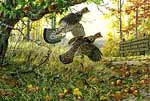
The invitingly remote waters of the Boundary Waters Canoe Area and Ontario’s Quetico Park provided the classroom in which I enjoyed my earliest canoe instruction. In the summer of 1965, the instructors at the Minnesota Outward Bound School used J- and draw strokes along with portages and woodcraft skills as sternly physical vehicles to deliver lessons of self discovery to us teenage boys.
Ten years later, I “discovered” recreational canoeing in the Adirondacks. With the exception of calling portages “carries,” New Yorkers enjoyed paddling a forest-framed mosaic of darkly beautiful and wild waterways much as did their Minnesota counterparts. Paddling within the “Blue Line” also offered occasional views of high peaks and a heightened sense of pride in my home state’s natural beauty as added perks.
By 1990, I was cheerily married to a wonderful North Country girl with whom I’d dabbled in several types of canoes and a pair of kayaks. I suspect that modern building materials and technologies were beginning to trickle into the recreational boat building market then, as we began to see advertisements for wood-and-laminate versions of the classic Adirondack Guide Boat. Intrigued, we arranged to try one on the water. When we met a retailer at a small pond nearby, he had already set his boat in a few inches of water on a gently sloping sandy beach. We waded in, hopped aboard, and spent ten delightful minutes putting the nimble craft through a series of tight turns and arrow-straight sprints. By the time we had driven home, we were committed to a custom order.
We were excited when we picked up our black and green boat in the spring of 1991. Our initial surprise – and viewed against our experience with canoes, it was a disappointing surprise – was the boat’s ungainly fit as a car topper. Our canoes had been generally lighter; less beamy amidships; and shaped more like a cigar than a football. As a result, I found the guide boat somewhat unwieldy and was unable to load the boat onto the car without a helper. Once up on the rack, we discovered that the guide boat had much more rocker, or curve, than our canoes. This design feature compromised visibility through both the forward and rear view glass of our SUV.
 Over the summer, we developed solutions to these new challenges on shakedown trips to the water. The good looking boat never failed to draw questions and positive comments from curious onlookers. The photos here were taken in August, 1991 on Indian Lake in Hamilton County. The lead photo clearly shows two features of guide boat design. The oars are "pinned" so that the guide could release one or both to take care of other business - presumably his sport's - without losing the ability to positively and effortlessly reacquire them. The cross over of the guide's hands at the completion of the stroke is also readily seen. In the bottom photo, yet another feature can be seen in the delicate taper of the oar's shaft from just below the pin down to the top of the blade. The relatively long, squared "handle" section of the oar from the pin to the grip, in combination with the tapered shaft, gave the rower great mechanical advantage while simultaneously providing a slight "shock absorber" effect in the narrow flex-and-release portion of the shaft. This combined benefit more than compensated the guide for learning to row using the cross-over finish.
Over the summer, we developed solutions to these new challenges on shakedown trips to the water. The good looking boat never failed to draw questions and positive comments from curious onlookers. The photos here were taken in August, 1991 on Indian Lake in Hamilton County. The lead photo clearly shows two features of guide boat design. The oars are "pinned" so that the guide could release one or both to take care of other business - presumably his sport's - without losing the ability to positively and effortlessly reacquire them. The cross over of the guide's hands at the completion of the stroke is also readily seen. In the bottom photo, yet another feature can be seen in the delicate taper of the oar's shaft from just below the pin down to the top of the blade. The relatively long, squared "handle" section of the oar from the pin to the grip, in combination with the tapered shaft, gave the rower great mechanical advantage while simultaneously providing a slight "shock absorber" effect in the narrow flex-and-release portion of the shaft. This combined benefit more than compensated the guide for learning to row using the cross-over finish.The third photo also gives some impression of the rocker built into the hull.
Although rowing is arguably a more efficient action than paddling, it comes with this cost: it's much easier for the rower to see where he's been than where he's going. Since I used the boat only for personal recreation - frequently solo recreation - I ultimately found the one-two punch of problematic car topping and reverse visibility sufficient to knock me out of guide boating. In 1994 I traded it for a Kevlar hulled, cane seated canoe. Even so, if I ever were to own a lake-front Adirondack camp where I could leave the boat near the water and use it whenever my wife or guest felt so inclined, I would definitely consider another purchase. For me, the lovely boats, a good companion and Adirondack flat water belong as synergistically close together as pancakes, blueberries and maple syrup.






1 comment:
Awesome post! I have toyed with a guide boat, but I think Cayuga's winds might mean my little pond is "too bigga water."
Nice little site you got goin here.
May I link to you?
Post a Comment